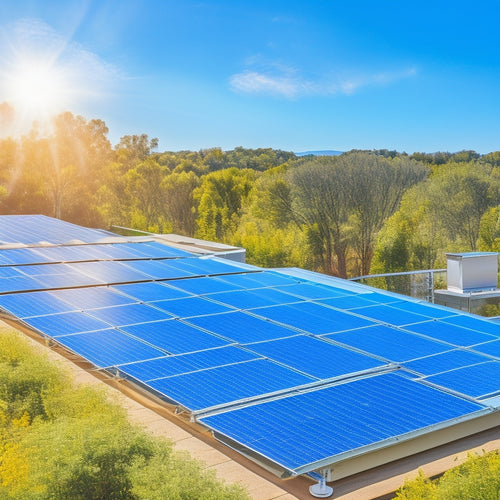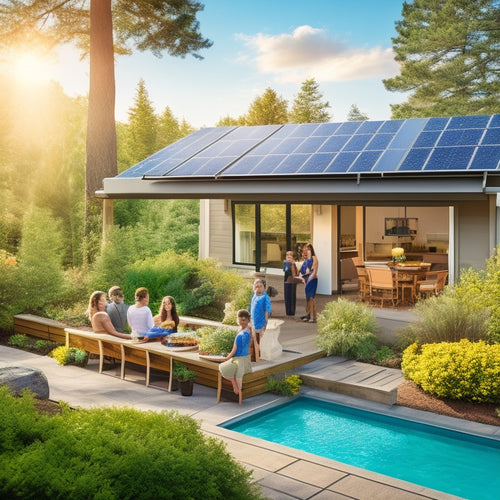
Harvesting Sunlight for Home Energy Savings
Share
By utilizing sunlight, you can greatly reduce your energy bills. To get started, you'll need to install solar panels, considering factors like roof size, orientation, and local building codes. High-efficiency panels can enhance energy output by up to 45%, and proper installation can maximize energy production. Conducting an energy audit will help identify areas of inefficiency in your home, and upgrading to energy-efficient appliances and lighting can streamline your energy usage. By combining these strategies, you'll not only reduce your reliance on the grid but also increase your energy independence - and there's more to investigate to optimize your energy savings.
Overview
- Siting and sizing solar panels correctly is crucial for optimal energy production and home energy savings.
- High-efficiency solar panels can boost energy output by up to 45%, maximizing energy savings potential.
- Conducting energy audits and implementing energy-efficient upgrades can significantly reduce home energy consumption.
- Storing excess energy generated by solar panels can reduce reliance on the grid and provide financial savings.
- Regular monitoring of energy production and consumption helps track savings and identifies opportunities for further improvement.
Solar Panel Installation Essentials
When considering solar panel installation, siting and sizing are essential aspects to get right from the outset.
You'll want to determine the best location for your panels, factoring in elements like roof size and orientation, shading, and local building codes.
Ideal system size is determined by location, energy usage, and roof space availability for maximum production. Proper sizing guarantees you're generating enough power to meet your energy needs.
There are several solar panel types to choose from, including monocrystalline, polycrystalline, and thin-film, each with its own efficiency and cost benefits.
Installation costs vary depending on the type and quality of equipment, as well as the complexity of the installation.
Maximizing Energy Output Potential
You can greatly increase your solar panel system's energy output by optimizing panel placement, considering factors like roof size, orientation, and shading.
Proper placement enables you to capture the maximum amount of sunlight, thereby increasing energy production. By doing so, you'll be able to generate more power and reduce your reliance on the grid.
High-efficiency panels can further improve energy output by up to 45% via optimized angles and tilt, allowing you to maximize energy harvesting even during low sunlight periods.
Optimize Panel Placement
Positioning solar panels at the ideal angle and orientation is crucial to maximize their energy output potential.
You'll want to take into account your roof angles, as a slope between 30 and 40 degrees is ideal for energy production. Additionally, a shading analysis will help identify areas where trees, buildings, or other obstructions may cast shade on your panels.
When selecting a mounting system, consider roof-mounted systems that can accommodate different roof types, including asphalt shingle, metal, and tile roofs.
By optimizing panel placement, you can minimize energy losses and guarantee your system operates at peak performance. For example, if you have a south-facing roof, you can angle your panels to capture the most direct sunlight.
Boost Energy Efficiency
Maximizing energy output potential requires fine-tuning your solar panel system to squeeze out every last kilowatt-hour.
You'll want to identify energy-wasting culprits in your home, and that's where energy audits come in. A thorough audit will pinpoint areas of inefficiency, allowing you to make targeted improvements.
Installing smart thermostats, for instance, can optimize your heating and cooling system's performance, slashing energy consumption. By streamlining your energy usage, you'll increase the effectiveness of your solar panel system.
This collaboration will maximize your energy independence, giving you more control over your electricity costs. By enhancing energy efficiency, you'll be utilizing the full potential of your solar investment, enjoying greater savings and freedom from the grid.
Reducing Home Energy Consumption
Cutting energy consumption at home requires a thorough understanding of where energy is being wasted. You can start by conducting an energy audit to identify areas of inefficiency. This will help you pinpoint opportunities to reduce energy waste and optimize your energy usage.
Consider installing smart thermostats, which can learn your schedule and preferences to regulate temperature and lighting. You can also upgrade to energy-efficient appliances and lighting fixtures.
Solar Power Storage Solutions
As you employ the power of solar energy, you're likely to encounter a common challenge: what to do with the excess energy your system generates during the day.
This is where solar power storage solutions come in. With advancements in battery technologies, you can now store excess energy for later use, reducing your reliance on the grid and saving you money on your energy bills.
Grid integration is also a vital aspect, allowing you to feed excess energy back into the grid and receiving credits for it.
Energy Efficiency Home Upgrades
You can considerably reduce heat loss and energy consumption by sealing air leaks tight, ensuring that your walls are properly insulated, and upgrading your window technology.
These upgrades will help prevent heated or cooled air from escaping, reducing the load on your HVAC system and saving you money on energy bills.
Seal Air Leaks Tight
Air leaks are the uninvited guests in your home, sneaking in through the tiniest openings and slipping out with your hard-earned energy dollars. To detect these sneaky leaks, you'll need to perform an air leak detection. This can be done by holding a lit incense stick or candle near potential leak areas. If the smoke wavers, you've found a leak.
| Common Air Leak Locations | Sealing Techniques |
|---|---|
| Windows and doors | Caulk, weatherstripping, or spray foam |
| Electrical outlets and switches | Seal behind outlet covers or use spray foam |
| Ducts and vents | Seal with mastic sealant or foil tape |
| Attic hatches and doors | Insulate and seal with weatherstripping |
| Baseboards and trim | Caulk or spray foam gaps and cracks |
Insulate Walls Properly
How much energy is escaping through your walls? Proper wall insulation is vital to prevent thermal bridging, where heat escapes through gaps in wall materials.
Check your walls for adequate insulation, especially in areas like electrical outlets, windows, and doors. Confirm that your wall materials, such as fiberglass, cellulose, or spray foam, are correctly installed and meet local building codes.
Don't overlook exterior walls, as they can account for up to 30% of heat loss. Insulate your walls properly to reduce energy consumption and enjoy significant home energy savings.
Upgrade Window Technology
Beyond the walls, your windows are another essential component of your home's thermal envelope, and outdated ones can be considerable energy wasters. Upgrading your windows with modern technologies can notably reduce heat loss and gain. Consider replacing old windows with ones featuring smart glazing, which can flexibly change its transparency to optimize energy efficiency. You can also apply window coatings to reduce heat transfer and minimize energy losses.
| Window Technology | Energy Efficiency Benefits |
|---|---|
| Smart Glazing | Flexibly adjusts transparency to optimize energy efficiency |
| Window Coatings | Reduces heat transfer and minimizes energy losses |
| Low-E Glass | Reflects heat rather than absorbs it, reducing energy losses |
Monitoring Your Energy Savings
You can track your progress and identify areas for improvement by regularly monitoring your energy savings.
With energy monitoring systems, you can see how much energy you're producing and consuming in real-time. This data helps you optimize your energy usage, making adjustments to maximize your savings.
Savings tracking software can also provide detailed reports on your energy production and consumption patterns, highlighting opportunities to reduce waste and increase efficiency.
Frequently Asked Questions
Can I Install Solar Panels on a Shaded Roof?
You can install solar panels on a shaded roof, but you'll need shaded roof solutions to optimize energy output. Consider panel placement, tree trimming, and specialized panels to minimize efficiency losses, ensuring you still capture significant solar power.
Do Solar Panels Work During Power Outages?
You're wondering if solar panels work during power outages; unfortunately, they don't, unless you have a backup battery system in place, which can maintain solar panel efficiency and provide you with continuous power.
Are Solar Panels Damaged by Hail or Heavy Snow?
You're wondering if solar panels can withstand harsh weather. Fortunately, most panels are built with hail resistance in mind, and snow accumulation typically doesn't cause damage; however, it's crucial to verify your system is installed with a durable mounting system and regular snow removal.
Can I Sell Excess Energy Back to the Grid?
As you unfasten your home's energy independence, you can indeed sell excess energy back to the grid through net metering, reaping benefits like reduced bills and attractive energy buyback rates, giving you the freedom to thrive.
Do Solar Panels Increase My Property Taxes?
You're wondering if solar panels will hike your property taxes; generally, they won't, as many states exempt renewable energy systems from property tax implications, ensuring you reap the solar panel benefits without added costs.
Ready to Buy
As you flip the switch, it's no coincidence that your energy savings add up. By capturing sunlight with solar panels, maximizing energy output, reducing consumption, and storing excess power, you've taken control of your home's energy efficiency. With smart upgrades and real-time monitoring, you're now reaping the rewards of a sustainable, cost-effective lifestyle. And, as it happens, the planet is thanking you too.
Related Posts
-

What Types of Solar Energy Devices Are Available
You'll find several types of solar energy devices available today, each customized to different energy needs. Photovo...
-

Top Portable Refrigerators for Camping Adventures
When you're camping, having a reliable portable refrigerator can make all the difference for keeping your food fresh ...
-

Top-Rated Home Solar Power Kits for Achieving Energy Independence
Top-rated home solar power kits enable you to achieve energy independence by greatly cutting your energy costs. You c...


